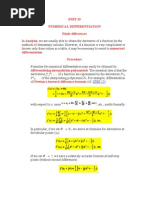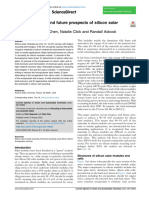0 ratings0% found this document useful (0 votes)
247 viewsNumerical Methods-FINALS
Numerical Methods-FINALS
Uploaded by
Ceasy Boy PeraltaThe document discusses various numerical integration and differentiation methods such as Trapezoidal rule, Simpson's rule, Lagrange interpolation, and Newton's interpolation. It provides true/false statements about the properties and applications of these methods. Key points include that Trapezoidal rule uses first degree polynomials to approximate integrals, Simpson's rule uses third degree polynomials, and Newton's interpolation can be used to find function values at points within the data range using divided differences. Uniform intervals are important for numerical integration methods like Trapezoidal rule and Simpson's rule.
Copyright:
© All Rights Reserved
Available Formats
Download as DOCX, PDF, TXT or read online from Scribd
Numerical Methods-FINALS
Numerical Methods-FINALS
Uploaded by
Ceasy Boy Peralta0 ratings0% found this document useful (0 votes)
247 views4 pagesThe document discusses various numerical integration and differentiation methods such as Trapezoidal rule, Simpson's rule, Lagrange interpolation, and Newton's interpolation. It provides true/false statements about the properties and applications of these methods. Key points include that Trapezoidal rule uses first degree polynomials to approximate integrals, Simpson's rule uses third degree polynomials, and Newton's interpolation can be used to find function values at points within the data range using divided differences. Uniform intervals are important for numerical integration methods like Trapezoidal rule and Simpson's rule.
Original Description:
Numerical Methods
Copyright
© © All Rights Reserved
Available Formats
DOCX, PDF, TXT or read online from Scribd
Share this document
Did you find this document useful?
Is this content inappropriate?
The document discusses various numerical integration and differentiation methods such as Trapezoidal rule, Simpson's rule, Lagrange interpolation, and Newton's interpolation. It provides true/false statements about the properties and applications of these methods. Key points include that Trapezoidal rule uses first degree polynomials to approximate integrals, Simpson's rule uses third degree polynomials, and Newton's interpolation can be used to find function values at points within the data range using divided differences. Uniform intervals are important for numerical integration methods like Trapezoidal rule and Simpson's rule.
Copyright:
© All Rights Reserved
Available Formats
Download as DOCX, PDF, TXT or read online from Scribd
Download as docx, pdf, or txt
0 ratings0% found this document useful (0 votes)
247 views4 pagesNumerical Methods-FINALS
Numerical Methods-FINALS
Uploaded by
Ceasy Boy PeraltaThe document discusses various numerical integration and differentiation methods such as Trapezoidal rule, Simpson's rule, Lagrange interpolation, and Newton's interpolation. It provides true/false statements about the properties and applications of these methods. Key points include that Trapezoidal rule uses first degree polynomials to approximate integrals, Simpson's rule uses third degree polynomials, and Newton's interpolation can be used to find function values at points within the data range using divided differences. Uniform intervals are important for numerical integration methods like Trapezoidal rule and Simpson's rule.
Copyright:
© All Rights Reserved
Available Formats
Download as DOCX, PDF, TXT or read online from Scribd
Download as docx, pdf, or txt
You are on page 1of 4
From the two data points(2,5) and (6, 11), using Lagrange polynomial
method, the polynomial is Li(x) = 1.5x +2.
= True
Reducing the equidistant points improves the approximation of the function,
f(x) by the polynomial, P.
= False
Simpson’s 1/3 rule is an example of an open type numerical integration
method
= False
In differentiation using numerical methods, one of the steps is interpolating
the function by a polynomial p at suitable points.
= True
The degree of the polynomial for the 10 sample values or data points is
equal to 10.
= False
The coefficients of the Newton's interpolating polynomial can also be
expressed in terms of divided difference.
= True
Using Lagrange interpolation, with data given below compute for f(1.5)
x0 = 0 f(x0) = 2
x1 = 3 f(x1) = 7
the solution is f(1.5) = 4.5
= True
In numerical integration, when both the end points of the interval of
integration are used as nodes in the methods, the methods are called
closed type methods
= True
Using Lagrange interpolation, with data given below compute for f(1.5)
x0 = 0 f(x0) = 2
x1 = 3 f(x1) = 7
x2 = 5 f(x2) = 9
the solution is f(1.5) = 4.8
= True
For a two segment trapezoidal rule, it will use the points similar to the ones
used by Simpson’s 1/3 rule.
= True
For an interval of 0 to 1, a subinterval with a size of 0.2 will give n = 5
described as 5 segment Trapezoidal rule.
= True
A cubic polynomial can interpolate three points.
= False
While using two sets of points (x0,y0) and (x1,y1) a straight line is formed and
could use the slope equation which follows that the first derivative can be
approximated using the given values.
= True
Simpson’s 1/3 rule uses a second degree polynomial formed by the two
points of the original function.
= False
First order differences is equivalent f[x0,x1] when i = 0.
= True
In Newton-Cotes integration methods, the nodes are uniformly
distributed in [a, b] with x0 = a, xn = band the spacing h = (b – a) / n.
= True
In using smaller integration interval for multiple segments, Trapezoidal
method can reduce the approximation error better than Simpson’s 1/3 rule
= False
Simpson's rule is a numerical method that approximates the value of a
definite integral by using third degree polynomials
= False
Another method called midpoint rule is an open type method numerical
integration.
= True
In numerical differentiation, using a very small step size may increase the
approximation error.
= True
It is possible to approximate a function by using values outside the data
points which is known as the linear interpolation.
= False
The coefficient a0 is also equal to f(x0) in the Newton’s interpolating
polynomial.
= True
Given the function f(x) = 0.75 + 1.1x, an exact value can be given instantly
by Trapezoidal rule
= True
Trapezoidal rule is a numerical method that approximates the value of a
definite integral by using first degree polynomial
= True
The approximate integral of
= False
Numerical integrations such as Trapezoidal and Simpson’s 1/3 rule should
have intervals that are uniform.
= True
Using Newton’s interpolation, with data given below to compute for f(1.5)
x0 = 0 f(x0) = 2
x1 = 3 f(x1) = 7
x2 = 5 f(x2) = 9
The first order from x0 = 0 to x1 = 3 has a value of 4.8 which is similar to
Lagrange.
= False
Using Newton’s interpolation, with data given below to compute for f(1.5)
x0 = 0 f(x0) = 2
x1 = 3 f(x1) = 7
x2 = 5 f(x2) = 9
The second ordervalue is 1/3.
= False
For both the Trapezoidal and Simpson’s 1/3 rule , using more strips will
give better approximation of the curve.
= True
The approximate integral of
= True
Using Newton’s interpolation, with data given below to compute for f(1.5)
x0 = 0 f(x0) = 2
x1 = 3 f(x1) = 7
x2 = 5 f(x2) = 9
The first order from x0 = 3 to x1 = 5 has a value of 1
= True
Only four points are needed in constructing a fourth order Newton Divided
Difference polynomial,
= False
Using Newton’s interpolation, with data given below compute for f(1.5)
x0 = 0 f(x0) = 2
x1 = 3 f(x1) = 7
x2 = 5 f(x2) = 9
The solution of Y(1.5)=4.8
= True
Thealgorithm of the Trapezoidalrule is described by
>>h=(b-a)/n
>>x=a sum=f(x)
>>for i=1:n-1
>>x=x+h
>>sum=sum+2*f(x)
>> end
>>sum=sum+f(b)
>>(b-a)*sum/(2*n)
= True
If the interval of the function is given as 0 to pi, for n = 6 segments, each
node or segments will be
= True
A continuous function’s integral is approximated using either the
trapezoidal or Simpson’s rule by translating the function into discrete form.
= True
The point was added to the Simpson’s 1/3 Rule which gives a
better approximation to the integral of the function.
= False
From the two data points (1,4) and (3, 7), and (4,10) using Lagrange
polynomial method, the polynomial is Li(x) = 0.5x2 -0.5x +2.
= False
If the function, f(x) = cos3x was approximated by the polynomial, P(1.5) = -
0.2, the amount of error approximately 0.05
= True
You might also like
- BL Ece 6205 Lec 1923t Signals Spectra Signal Pro Final ExamDocument77 pagesBL Ece 6205 Lec 1923t Signals Spectra Signal Pro Final Examanembam putobungbong100% (1)
- Logic Circuit Switching TheoryDocument21 pagesLogic Circuit Switching TheoryMark Anthony Corpuz67% (3)
- Prelim Exam - Attempt Review 23outof30Document12 pagesPrelim Exam - Attempt Review 23outof30Erick GarciaNo ratings yet
- Epicor Service Connect 10 For Epicor ERP Course 10.0.700Document87 pagesEpicor Service Connect 10 For Epicor ERP Course 10.0.700nerz883067% (3)
- NUMERICAL METHODS PRELIM LABORATORY EXAMINATION Attempt Review PDFDocument20 pagesNUMERICAL METHODS PRELIM LABORATORY EXAMINATION Attempt Review PDFJitlee PapaNo ratings yet
- Prelim Exam - Attempt Review 28outof30Document11 pagesPrelim Exam - Attempt Review 28outof30Erick GarciaNo ratings yet
- Finals - Attempt ReviewcircuitDocument13 pagesFinals - Attempt ReviewcircuitRony Maea40% (5)
- Csc134 Individual AssignmentDocument2 pagesCsc134 Individual AssignmentSyairah AhmadNo ratings yet
- Mid Exam SIGNALSDocument24 pagesMid Exam SIGNALSJitlee Papa100% (1)
- UGRD-ENG6203-Engineering-Economics-legit-not-quiezess MidALLDocument14 pagesUGRD-ENG6203-Engineering-Economics-legit-not-quiezess MidALLJitlee PapaNo ratings yet
- Final Quiz 1 3Document3 pagesFinal Quiz 1 3Erick GarciaNo ratings yet
- Signals Spectra and DSPDocument13 pagesSignals Spectra and DSPLegenGary100% (1)
- THESIS 2 - Prelim Quiz 1Document9 pagesTHESIS 2 - Prelim Quiz 1JaniceRemateNoble100% (1)
- Prelim Exam - Attempt ReviewDocument13 pagesPrelim Exam - Attempt ReviewErick GarciaNo ratings yet
- Midterms - Attempt Review4 PDFDocument11 pagesMidterms - Attempt Review4 PDFRony MaeaNo ratings yet
- PrelimDocument26 pagesPrelimeun mun kang100% (3)
- Calculus 2 Final QuizzesDocument14 pagesCalculus 2 Final QuizzesJamie HillNo ratings yet
- Oils and Fats Processing Technology - Lecture NoteDocument457 pagesOils and Fats Processing Technology - Lecture Notefaranimohamed90% (10)
- Prelim Quiz 2 - Attempt Review 9outof10Document5 pagesPrelim Quiz 2 - Attempt Review 9outof10Erick GarciaNo ratings yet
- Final Quiz 1 - Attempt Review 4Document4 pagesFinal Quiz 1 - Attempt Review 4Erick GarciaNo ratings yet
- Midterm Exam - Attempt ReviewDocument16 pagesMidterm Exam - Attempt ReviewErick GarciaNo ratings yet
- Final Quiz 1 - Attempt Review 2Document4 pagesFinal Quiz 1 - Attempt Review 2Erick GarciaNo ratings yet
- Midterm Exam - Attempt Review 1Document15 pagesMidterm Exam - Attempt Review 1Erick GarciaNo ratings yet
- Final Quiz 2Document4 pagesFinal Quiz 2Erick GarciaNo ratings yet
- Logic Circuit & Switching Theory Pre - Final Quiz 1Document14 pagesLogic Circuit & Switching Theory Pre - Final Quiz 1Russel Mendoza100% (1)
- Midterm Exam - Attempt Review 2Document15 pagesMidterm Exam - Attempt Review 2Erick Garcia100% (1)
- Final Quiz 1 - Attempt Review 1Document3 pagesFinal Quiz 1 - Attempt Review 1Erick GarciaNo ratings yet
- Sprctra FinalsDocument21 pagesSprctra Finalsanembam putobungbong100% (1)
- Electronic Circuit Midterm Lab Exam 92%Document14 pagesElectronic Circuit Midterm Lab Exam 92%marieNo ratings yet
- Midterm Exam 1Document15 pagesMidterm Exam 1Erick Garcia0% (1)
- Midterm Exam 2Document14 pagesMidterm Exam 2Erick Garcia100% (1)
- Final Quiz 2 3Document4 pagesFinal Quiz 2 3Erick GarciaNo ratings yet
- Computer Aided Drafting Final Quiz2Document9 pagesComputer Aided Drafting Final Quiz2Russel MendozaNo ratings yet
- Final Quiz 2 - Attempt Review 1Document4 pagesFinal Quiz 2 - Attempt Review 1Erick GarciaNo ratings yet
- Finals DSP WithMinimalErrors PDFDocument64 pagesFinals DSP WithMinimalErrors PDFanembam putobungbongNo ratings yet
- UGRD-EE6301-Feedback-and-Control-Systems-Overall-Midterm QuizessDocument13 pagesUGRD-EE6301-Feedback-and-Control-Systems-Overall-Midterm QuizessJitlee PapaNo ratings yet
- Electronic Circuit-MIDTERMDocument25 pagesElectronic Circuit-MIDTERMCeasy Boy PeraltaNo ratings yet
- Numerical Methods-PRELIMSDocument4 pagesNumerical Methods-PRELIMSCeasy Boy PeraltaNo ratings yet
- Numerical Methods Final ExamsDocument21 pagesNumerical Methods Final ExamsMattew NograNo ratings yet
- THESIS 2 - Prelim Quiz 2Document8 pagesTHESIS 2 - Prelim Quiz 2JaniceRemateNobleNo ratings yet
- Differential Equation Prelims1, Prelims 2Document54 pagesDifferential Equation Prelims1, Prelims 2Vickoro Almazor100% (2)
- Final Quiz 1 1Document3 pagesFinal Quiz 1 1Erick GarciaNo ratings yet
- Prelim Exam - Attempt Review ECE 6331Document5 pagesPrelim Exam - Attempt Review ECE 6331Allen JoshuaNo ratings yet
- Midterm Exam - Attempt Review ECE 6331Document5 pagesMidterm Exam - Attempt Review ECE 6331Allen Joshua100% (1)
- Midterm Exam Differential 231Document25 pagesMidterm Exam Differential 231Amiel Hana Lem ManaloNo ratings yet
- ECE6200 Assignment 2 P1Document233 pagesECE6200 Assignment 2 P1Jitlee PapaNo ratings yet
- UGRD-MATH6231 Differential Equation: by SLVNDocument32 pagesUGRD-MATH6231 Differential Equation: by SLVNJitlee Papa100% (2)
- My CoursesDocument18 pagesMy Coursesmarlon corpuzNo ratings yet
- Feedback Final Quiz 1 Attempt ReviewDocument4 pagesFeedback Final Quiz 1 Attempt Reviewanembam putobungbong100% (1)
- CS6398 Midterm Exam Attempt Review PDFDocument17 pagesCS6398 Midterm Exam Attempt Review PDFGraceann Gocalin100% (1)
- Information Assurance Security 12Document18 pagesInformation Assurance Security 12laloNo ratings yet
- UGRD-ECE6205-Signals-Spectra-and-Signal-Processing-legit-not-quizess MidALLDocument19 pagesUGRD-ECE6205-Signals-Spectra-and-Signal-Processing-legit-not-quizess MidALLJitlee Papa100% (3)
- Cad (Blended)Document100 pagesCad (Blended)Dianne Diaz100% (2)
- UGRD RSCH6352 2213T Final Quiz 1 100Document9 pagesUGRD RSCH6352 2213T Final Quiz 1 100Dr.DokieNo ratings yet
- Data Analysis Final Quiz 1 ExamDocument5 pagesData Analysis Final Quiz 1 ExamMacrio MallillinNo ratings yet
- MATH 6200 2013T UGRD Data Analysis Midterm Exam - PDF 1Document10 pagesMATH 6200 2013T UGRD Data Analysis Midterm Exam - PDF 1Josh del RosarioNo ratings yet
- Computer Engineering Drafting and Design Prelim Quiz 2Document7 pagesComputer Engineering Drafting and Design Prelim Quiz 2Russel MendozaNo ratings yet
- Final Quiz 1 - Attempt ReviewDocument3 pagesFinal Quiz 1 - Attempt ReviewErick GarciaNo ratings yet
- Final Quiz 1 - Attempt Review 3Document3 pagesFinal Quiz 1 - Attempt Review 3Erick GarciaNo ratings yet
- UGRD ECE6203 Electronics 2 Electronic Circuit Analysis and Design pq1Document3 pagesUGRD ECE6203 Electronics 2 Electronic Circuit Analysis and Design pq1Marlon Baltazar CorpuzNo ratings yet
- Vu SolvedDocument60 pagesVu SolvedImranShaheenNo ratings yet
- Numerical MethodDocument8 pagesNumerical Methodommprakashpanda15scribdNo ratings yet
- Num 1Document15 pagesNum 1Bhumika KavaiyaNo ratings yet
- Mixed Signals-MIDTERM-EXAMDocument19 pagesMixed Signals-MIDTERM-EXAMCeasy Boy PeraltaNo ratings yet
- Mixed Signals and Sensors-PRELIMSDocument4 pagesMixed Signals and Sensors-PRELIMSCeasy Boy PeraltaNo ratings yet
- Electronic Circuit-MIDTERMDocument25 pagesElectronic Circuit-MIDTERMCeasy Boy PeraltaNo ratings yet
- Electronic Circuit-PRELIMS EXAMDocument16 pagesElectronic Circuit-PRELIMS EXAMCeasy Boy PeraltaNo ratings yet
- Basic Occupational Health and Safety-MIDTERMDocument42 pagesBasic Occupational Health and Safety-MIDTERMCeasy Boy PeraltaNo ratings yet
- Numerical Methods-MIDTERMDocument8 pagesNumerical Methods-MIDTERMCeasy Boy PeraltaNo ratings yet
- Numerical Methods-PRELIMSDocument4 pagesNumerical Methods-PRELIMSCeasy Boy PeraltaNo ratings yet
- Accountancy Finance Keywords PDFDocument2 pagesAccountancy Finance Keywords PDFNumair AshrafNo ratings yet
- Sustainable Development As Freedom: Trends and Opportunities For The Circular Economy in The Human Development LiteratureDocument26 pagesSustainable Development As Freedom: Trends and Opportunities For The Circular Economy in The Human Development LiteratureLuiz Vicente NetoNo ratings yet
- Round Baler Productivity Guide PM 13750Document36 pagesRound Baler Productivity Guide PM 13750Adrian EGNo ratings yet
- Agriculture and Climate Change. Challenges and Opportunities at The Global and Local LevelDocument56 pagesAgriculture and Climate Change. Challenges and Opportunities at The Global and Local LevelJorge Samaniego EguigurenNo ratings yet
- Matematika Dasar - TurunanDocument46 pagesMatematika Dasar - TurunanAkbarudin YusufNo ratings yet
- A. Brief History/Background of The Company/company Profile Brief HistoryDocument7 pagesA. Brief History/Background of The Company/company Profile Brief HistoryIan TalaueNo ratings yet
- 629 and 619B Backhoe Parts ManualDocument28 pages629 and 619B Backhoe Parts ManualMac KrisNo ratings yet
- Fed ExDocument22 pagesFed ExAnup PopliNo ratings yet
- Technical Leaflet Cim 795Document7 pagesTechnical Leaflet Cim 795blindjaxxNo ratings yet
- LRTA v. Quezon CityDocument13 pagesLRTA v. Quezon CityRONALD CALDERONNo ratings yet
- Rudolph ("Rudy") William Louis Giuliani Ethics Complaint - RedactedDocument3 pagesRudolph ("Rudy") William Louis Giuliani Ethics Complaint - RedactedAlbert cahn100% (2)
- Analysis of Home Depot's Financial Performance:: Current RatioDocument4 pagesAnalysis of Home Depot's Financial Performance:: Current RatioDikshaNo ratings yet
- LCM 60DA SpecDocument8 pagesLCM 60DA SpecAlex FilipovicNo ratings yet
- Electrical Progress Job Card. (IFC)Document28 pagesElectrical Progress Job Card. (IFC)Rudren Eswaran KrishnanNo ratings yet
- IRNSS Journal PaperDocument14 pagesIRNSS Journal PaperRizwan SPNo ratings yet
- Check List For BTSDocument1 pageCheck List For BTSWin LinnNo ratings yet
- Trixpoint Com How Old To Lease A CarDocument6 pagesTrixpoint Com How Old To Lease A Cartrixpoint990No ratings yet
- Pressure Gauge - O&MDocument16 pagesPressure Gauge - O&MMitul PatelNo ratings yet
- Facts: Sadhana Nabera V. SebiDocument6 pagesFacts: Sadhana Nabera V. SebiPrajakta JoshiNo ratings yet
- CSEC Human and Social Biology SBA GuidelinesDocument2 pagesCSEC Human and Social Biology SBA Guidelinesmissjackson042No ratings yet
- Recent Progress and Future Prospects of Silicon Solar Module RecyclingDocument9 pagesRecent Progress and Future Prospects of Silicon Solar Module RecyclingXiaotu MaNo ratings yet
- 540-780 Mpa Grade Hot-Rolled Steel With Excellent FormabilityDocument3 pages540-780 Mpa Grade Hot-Rolled Steel With Excellent Formabilitydhafi keceNo ratings yet
- Trolley Lorry Material TrainDocument39 pagesTrolley Lorry Material Trainshuja2008No ratings yet
- 509-International AccountingDocument8 pages509-International AccountingabNo ratings yet
- PDF Just Democracy The Rawls and Machiavelli Programme 1st Edition Philippe Van Parijs downloadDocument60 pagesPDF Just Democracy The Rawls and Machiavelli Programme 1st Edition Philippe Van Parijs downloadduriimvydt53100% (3)
- Adobe Scan 27-May-2024Document1 pageAdobe Scan 27-May-2024Gaurav_Mehra_1313No ratings yet
- Lembar Jawaban 1 UPK (Kevin J)Document12 pagesLembar Jawaban 1 UPK (Kevin J)kevin jonathanNo ratings yet






























































































